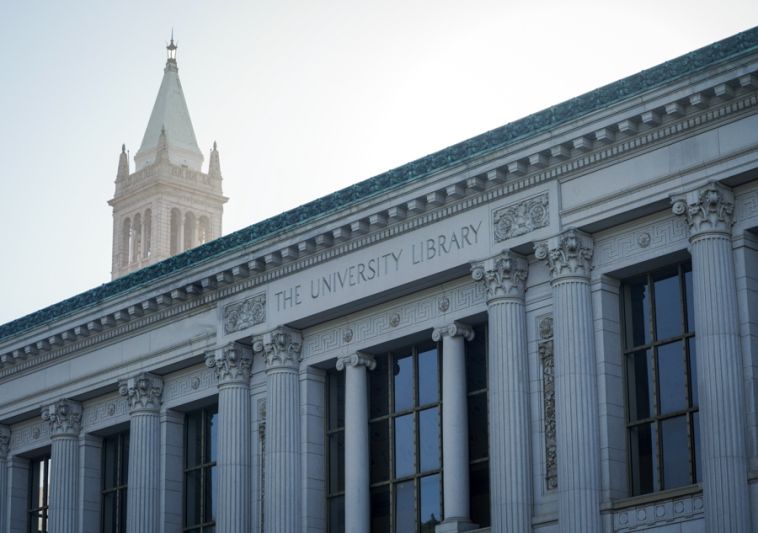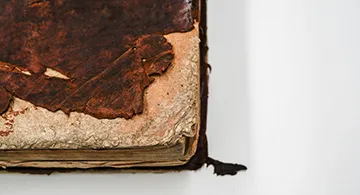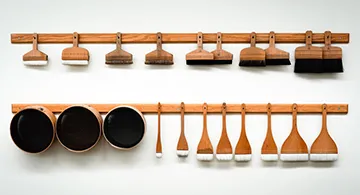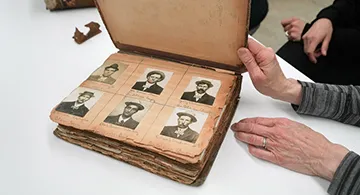About
The Preservation Department pursues four objectives toward achieving its goal of maintaining the collections in serviceable condition:
- All collections are protected against catastrophic loss from disaster. A written disaster response and collection salvage plan is maintained by the Preservation Department to facilitate emergency salvage operations. Salvage equipment is kept on site, and a cache of supplies adequate for salvaging 100,000 volumes is maintained by the libraries of the UC system.
- Damaged and deteriorated general collections materials are repaired or replaced in order to continue to provide library service. The Berkeley collections are used 3-4 million times a year. Artifactually significant special collections are conserved and put in individual protective enclosures to minimize wear. Treatment is kept to a minimum to avoid unwanted modifications of original books and documents and to extend preservation care to as many volumes in the collection as possible with available resources.
- Newly acquired materials especially vulnerable to damage or loss of parts are preserved on receipt through library binding and individual protective enclosures. A large percentage of the Library’s preservation resources is dedicated to the library binding program in order to take full advantage of the long-term preservation benefits that accrue from preservation action taken early in the use life of collections.
- Collections are maintained in environmental conditions favorable to their long-term survival. While the San Francisco Bay Area has a climate relatively benign to paper-based collections, newly constructed libraries and storage facilities include relative humidity control and air filtration to maximize the service life of the collections.
Additional goals of the Preservation Department are to contribute to the profession by participating in education and training of Preservation personnel, and to the research library community through leadership in Preservation work at university-wide, statewide, and national levels.
More about the Preservation Department
Binding
The Binding Preparation Division (BPD) is the interface unit between the UC Berkeley Library and the UC Bindery, responsible for receiving, tracking, processing, and shipping all materials to be bound by the Bindery.
Location:
209 Moffitt Library
University of California, Berkeley
Berkeley, CA 94720-6000
Each year, many thousands of books and serials are processed through BPD to the Bindery, where they are bound or otherwise protected and then returned to BPD and distributed back into the Library system. The unit is usually staffed by 2 full-time employees and several student library employees.
The Bindery offers a variety of binding styles and protective containers; most materials processed for the UC Berkeley Library fall into the following classifications:
- Pam Bind: used for pamphlets (text less than 3/8 " thick and up), stapled into a binder with a high-density back board, a spine covered with acrylic-coated cloth, and a front cover of clear polyester.
- Mylar: used for most paperbacks (text 1/2-2" thick). The covers are removed, laminated with Mylar and backed with binders board; the textblock is adhesive bound, if necessary, then encased by the laminated original cover.
- FC-Bind: (text 1/2-2" thick ) used for paperbacks without covers and serials that will receive limited circulation ("FC"). Leaves are adhesive-bound, the spine is reinforced with buckram. The buckram is stamped with title and call# information. The covers are high-density blue binders board, coated with acrylic for additional protection.
- Buckram: (text 3/8" thick and up) is reserved for volumes that need maximum protection, either because the volume is too thick or heavy for other types of binding, or because it receives heavy usage. Pages are oversewn, sewn through the fold, or adhesive bound. Covers are made with acrylic-coated buckram.
- Kasemake Box: protective container used for books or documents that for reasons of fragility or artifactual value, or the need to keep its several parts together, cannot or should not be bound. These boxes are fabricated from archival board from specifications provided by the Preservation Department.
Conservation
The Conservation Treatment Division provides conservation and consultation services for the collections of the Library. Conservators and curators work together to establish priorities and treatments, which vary depending on the character and needs of the materials; preventive and collection conservation approaches are used.
Location:
9 Doe Library
University of California, Berkeley
Berkeley, CA 94720-6000
Treatments
- paper repair
- flattening and dry cleaning of paper and photographs
- reattaching spines, boards, and loose leaves
- aqueous treatments (washing, de-acidifying, and lining paper)
- re-sewing text blocks
- cloth and leather re-backing
- new bindings (paper, cloth, leather, vellum)
- encapsulation of sheets and post binding
Protective enclosures
Many items are put into protective enclosures as part of an ongoing program to minimize wear and damage to the collections.
- encapsulations
- clamshell boxes
- graphic enclosures
- drop spine boxes
- portfolios
Consulting
- collection care
- environmental management
- handling practices
- exhibits
- repair/conservation of damaged materials
Collection salvage
- library materials damaged by water, fire, mold, or vermin
Replacement
The Preservation Replacement Division (PRD) offers these services:
- replacement of brittle books too deteriorated to continue to be used
- replacement of pages missing from books
- replacement of out-of-print whole books and serial issues missing from the collection
With the exception of projects, most of PRD's work is "use-driven," that is, it is identified by the library users when they need materials that prove to be missing from the collection, missing pages from volumes, or are in too poor physical condition to be used. Additionally, library staff identify items for possible replacement and forward them to PRD.
Replacement of brittle books
Identification of candidates: The "brittle books" program addresses the needs of the collection materials currently in demand, but too deteriorated to use. Items are flagged in the Conservation Treatment Division from among items that cannot be repaired or rebound. PRD staff document the physical condition information and propose replacement options.
Bibliographic checking: Before replacement, books are reviewed by a subject specialist (selector). Prior to selector review, PRD staff do bibliographic checking to identify copies at other libraries that could be borrowed by UCB Library users, and to identify copies for possible purchase.
Selector review and follow-up: The selector reviews the bibliographic information provided and decides on one of the following courses of action:
- Withdraw without replacement (PRD or Circulation processes the item for withdrawal)
- Retain as is (reshelve the item or transfer the item to NRLF)
- Replace commercially (purchase a duplicate copy, reprint, or different edition, or purchase the item in another format)
- Replace inhouse (make a preservation photocopy)
- Preserve in protective enclosure (clamshell box)
Replacement of missing pages
Review: Before a book with missing pages comes to PRD it is reviewed by technicians in the Conservation Treatment Division (CTD) to determine whether it is in good enough condition to withstand tip-ins. After missing page replacements are produced by PRD, the CTD technicians attach the replacement pages.
Borrowing: Replacement pages are made from intact copies obtained via the Interlibrary Borrowing Service (IBS) or, when possible, from other copies on campus. When source copies are to be drawn from non-circulating materials, as often happens with recent journals and reference books, PRD obtains photocopies of the needed pages via IBS and then recopies them with adequate binding margins. Replacement pages are two- sided, sized to match the original, and printed either on white or cream colored paper to blend with the original document.
Photocopying: Missing color plates and maps are often, but not always, replaced with color photocopies. If a large number of color copies is needed to complete the job, the PRD staff check the commercial availability of the book to determine if the more economical course of action would be to commercially replace the damaged copy. If a commercial replacement is not available the PRD staff will consult with a selector to decide whether color copying is worth the expense.
Replacement of missing whole items
Requests for replacement of missing books or serial issues usually come to PRD when the Order Division staff have been unable to locate a new or used copy and the selector has opted for replacement with a photocopy made by the Preservation Department.
Disaster
Localized emergency
The UC Library Collections Salvage Plan provides instructions to designated Library Managers for response to a localized non-catastrophic emergency affecting the collections of one unit. The plan is maintained and updated annually by the Preservation Department and is intended to be used for salvaging the collections when water damage has occurred. It is presumed that the buildings housing the affected collections have been inspected and are safe for entry at the beginning of salvage operations. The current Collections Salvage Plan includes:
- instructions for immediate response
- designated response personnel
- instructions for salvage of materials and the procurement of needed supplies
- salvage priorities for Main and Subject Libraries with color coded floor plans
- listing of UC and external resources available to provide assistance
Catastrophic emergency
In the event of a widespread catastrophic emergency, priority will be given to human safety and support. Collection salvage operations will not commence until the buildings housing the collections have been assessed and declared "safe for entry" by a Campus Inspection Team. An individual Building Emergency Plan (BEP) exists for each building housing library collections and interfaces with the overall Campus Recovery Plan. Designated Preservation personnel are included in the Library Administrative Recovery Team which will manage and coordinate recovery efforts, and are included in the list of designated emergency staff charged with assisting recovery efforts.
In a catastrophic emergency, it is unlikely there will be adequate staff to recover all collections. Damage in multiple locations will result in competing demands for salvage. Collection salvage priorities therefore change from the priorities listed by the unit to the following criteria established by the Library Collections Advisory Group:
- UCB created bibliographic tools existing only in paper copy
- Library business records in paper, e.g., records of donations of gifts or records of legal documents essential to operation and not duplicated elsewhere
- Unique and other irreplaceable materials
- High-use materials essential to the recovery of services
Give
Staff in the Preservation Department take considerable pride in providing a high level of responsiveness to urgent Library preservation needs and in accomplishing as much work as possible toward meeting overall collection needs. However, funding is not sufficient to preserve all of Berkeley's collections for future use by students and scholars.
The Department is very fortunate to have several endowments thus far to underwrite preservation staff, supplies, and services. The Hans Rausing Conservatorship Fund supports preservation of the paper-based collections. The UCB Class of '56, perhaps is the first class at a major university to make endowing the Library preservation program its class goal, supports a position for a library conservator.
Gifts to the UCB Library earmarked for preservation of the collections greatly enhance the Library's ability to provide preservation care. Hundreds of gifts from individual donors each year, from a few dollars to a few thousand dollars, enable the Preservation Department to make much more progress than could be made on State funds alone. Inquiries about opportunities for giving to the Library preservation program can be made to the Head of the Preservation Department, Hannah Tashjian. Click here to support the Preservation Department.
Contact
-

-

-

-

-
 Rosemary Sallee
Rosemary Sallee
Unit Head for Bindery Preparation and Preservation Replacement
rosemarysallee@berkeley.edu
Location

20 Doe Library
University of California
Berkeley, CA 94720-6000
This location is wheelchair accessible.


